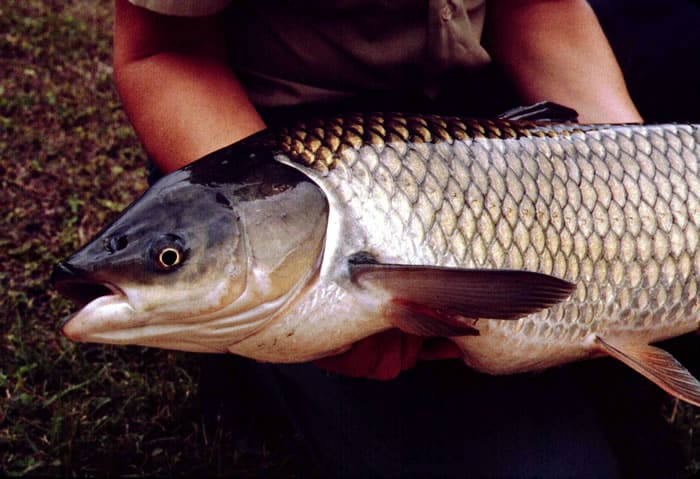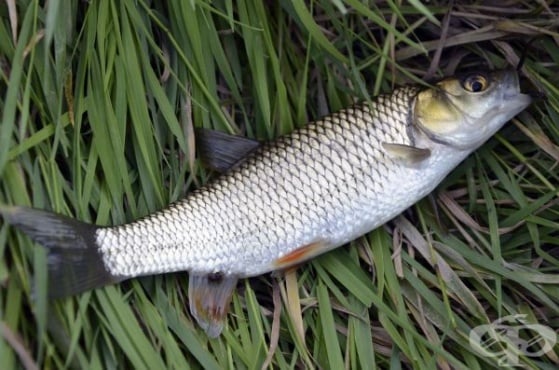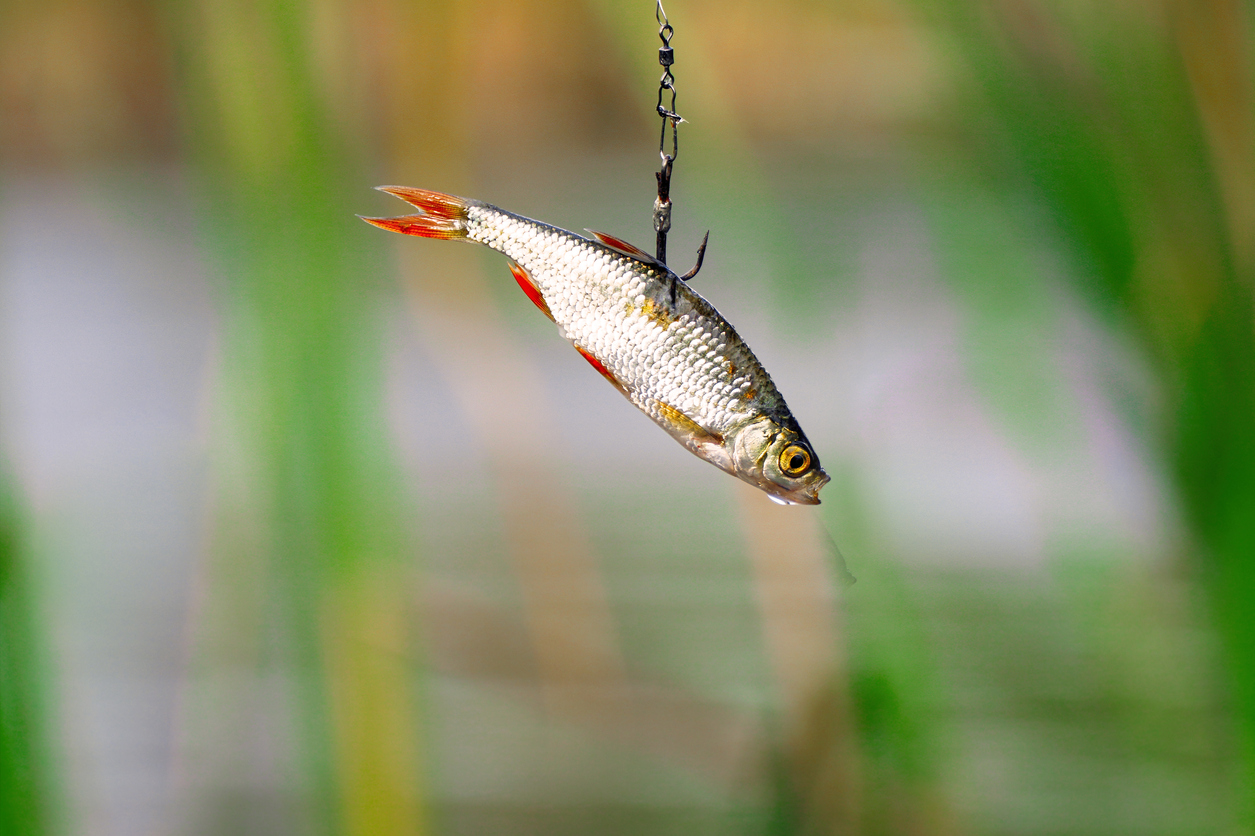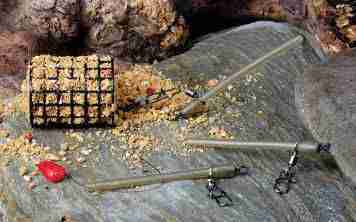
Paternoster For Feeder - nodes, options, application features

18 min read
Fishing for feeder fish is a great way to stock your pond or aquarium. There are many different types of feeder fish, so you can choose the best option for your needs. Feeder fish are typically small and easy to catch, making them a perfect choice for those new to fishing.
Paternoster For Feeder
All feeder rigs are connected in some way to the paternoster. Many of them are just similar feeder options sharpened for other fishing conditions. Do not look for the best editing - this does not exist. Some feeder rigs work better in the current, others work better in passive fish. Initially, it is impossible to predict which is better, especially on an unfamiliar body of water. A feederism needs to own several in order to cover as many different features of fish biting as possible, and to look for a specific montage that works today during fishing.
It is convenient for a beginner in the feeder to start with this simplest option at first glance. However, in the course of reading this article, beginners will be convinced that this installation is not as simple as it seems at first glance. And its capabilities are not at all entry-level.
Pros
- Easy to make; Great sensitivity. The angler can directly feel the bite of the fish with the rod;
- Shows itself well on long casts; Does not get bogged down in silt, or rocky bottom.
Cons
- The twist with a leash often “floats” near the bottom, which makes it noticeable to the fish. Therefore, Paternoster has proven itself primarily on reservoirs without a current.
- The sensitivity is still less than that of a non-symmetrical (asymmetric) loop and inline rig.
Installation paternoster (Paternoster Rig) in its classic form and with this name came to us from England, along with the feeder. But this does not mean that such equipment was not familiar to domestic fishermen. Here is the classic pattern:
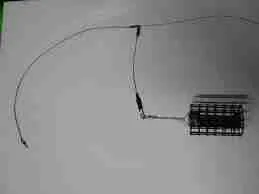
Doesn’t it remind you of anything? That’s right, in fact - this is a good old diversion leash with a deaf load at the end for our native snack. It’s just that this leash is much longer than the segment that goes to the sinker.
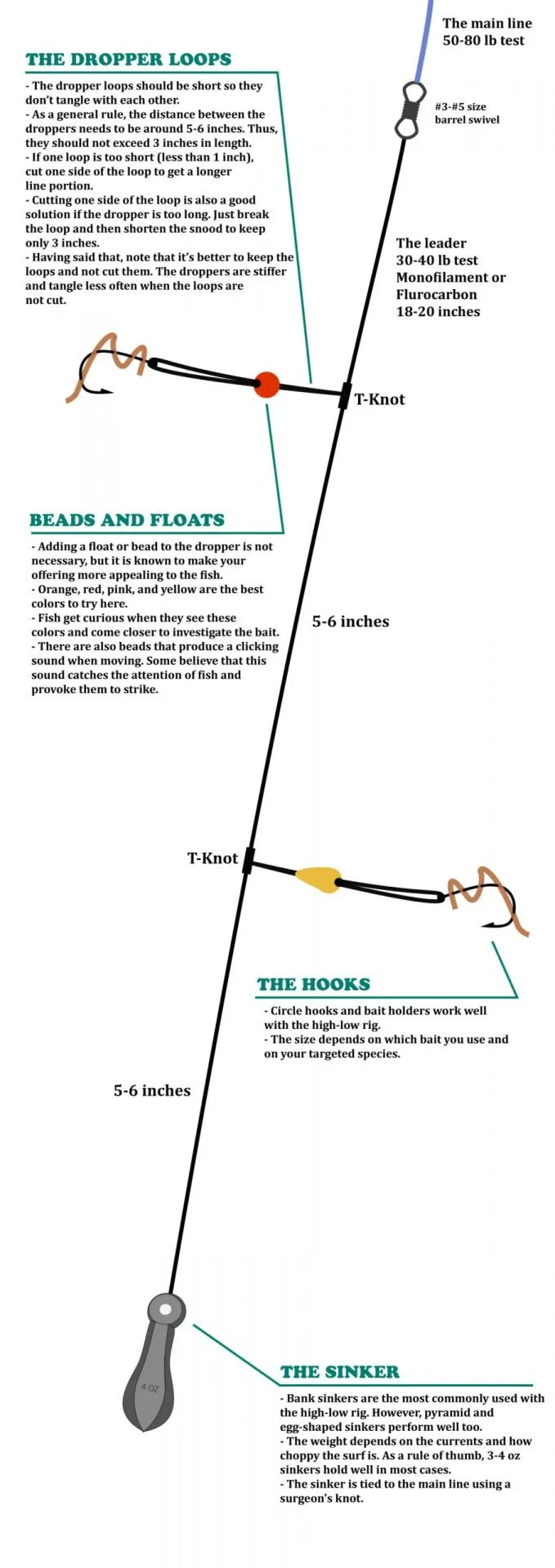
The main problem of the hook rig is the constant wrapping of the main fishing line with a leash, overwhelming it. In the paternoster rig for the feeder, this is solved just by the longer shoulder of the thick fishing line (main), going to the leash, and not to the feeder.
The English feeder rig is an improved version of the shackle installation familiar to all bottomers. If we continue, then there are more various such improvements - then we will consider in detail all the nuances.
Feeder paternoster is a very sensitive tackle, however, not always. Therefore, you need to master several installations. But on those fishing trips, when he works and detects fish from every bite, there is no replacement for this equipment.
Varieties of Paternoster Gardner
Fishermen are smart and very resourceful people. That is why the classic Gardner paternoster has several analogues, tailored to certain fishing conditions. To make it clearer why they are needed, we will display them in a table.
As you can see, the paternoster equipment is multifaceted. Under this term “hidden” are several very effective designs for catching fish, but only if they are used correctly. Consider in more detail the manufacture of each of them.
Knots instructions, subtypes
At present, in modern feeder fishing, there are a number of modifications of loop knitting, which do not differ significantly from the original, classical method invented by the author. The differences are in the assembly of the installation with additional mounting accessories and elements that prevent tangling. Before knitting a Gardner paternoster for a feeder, the angler will need a certain composition of materials, the list of which can be unified, taking into account all kinds of knitting options.
To assemble the installation, the angler will need to prepare:
1. The main fishing line - on which the installation will be based.
2. Feeding trough - simultaneously acting as a sinker.
3. Swivel in tandem with a carabiner - serves to fasten the feeder.
4. Stopper - to limit the movement of the feeders.
5. Fluorocarbon or nylon line - used as a rig leader.
6. Hook - the size of which is selected based on the bait used and the size of the trophy planned in the catch.
For the design of equipment, main fishing lines of various materials and different thicknesses are suitable, capable of withstanding the weight of the filled feeder and the resistance of the fish being pulled. After checking the availability of the required elements, it is enough to familiarize yourself with the instructions for forming loop variations presented below and begin to develop assembly skills.
How to make a do-it-yourself Paternoster installation
We will tell you how to properly make a classic version for amateur anglers, and finish with sports equipment.
Required components:
- Swivel with carabiner;
- Load-feeder;
- Monofilament fishing line 0.2-0.3 mm;
- Thinner monofilament 0.15-0.25 mm (for classic);
- Fluorocarbon fishing line 0.1-0.18 mm;
- Swivel without carabiner (for sports equipment).
Classic paternoster and ledgering
Before making the paternoster in its original version, let’s analyze where this marvel came from. Initially, this option exactly appeared in the English method of bottom fishing - ledgering. Ledger Rig - someone like Ledger was the first to come up with such a rig.
Ledgering - for us it is fishing with a bottom from the shore at close range when casting from behind is not needed or impossible (bushes, trees). In England, this term is generally understood as bottom fishing in principle. Usually, this method is effective when you don’t need to throw the feeder far in principle - a pit or edge right under your feet near the shore, a few meters from the angler. The feeder is cast from under the skirt, like a float rod, and baiting is done by hand with balls to the fishing point. So, the paternoster in the classical version was seen for the first time exactly there (more precisely, its essence).
The classic paternoster was specially designed for sections of rivers clogged with branches and snags, for short fishing from the shore, and also for plumb fishing from a boat. Therefore, the leash is attached to the continuation of the main fishing line. The branch for the feeder (in ledgering - for the sinker) is obviously made from thinner and weaker fishing line.
This was invented so that in the event of a hook with a load when playing, it comes off, and not a fish on a leash. In our conditions for feeder fishing, such an installation is also suitable for fishing in littered places, only a feeder is installed instead of a sinker. By the way, in the smallest rivers, feeder lovers can completely catch any fish completely according to the canons of ledgering, only with a feeder (such casting is prohibited in sports).
A thin branch to the feeder is just as easy to knit. We fold the main fishing line (0.25-0.3 mm) together with a thin one (for example, about 2 mm), and also tie it with a figure eight or a triple knot. We attach a leash to a thick branch, a feeder to a thin branch.
Modern European ledgering is often used already with sliding rigs, and from a boat. By the way, this method of fishing with close casting is perfect for us for fishing with a feeder from a boat. And in general, in this method of fishing, you can use any other installations. Just a classic paternoster - the ancestor of all other montages in the feeder.
Amateur paternoster
Our anglers usually do not bother like that and make paternoster feeder rigs with hook and feeder leads of the same diameter. The rig is knitted directly on the main line, the shock leader of the feeder (if used), or separately, on a rigid 0.3 mm feeder line or fluorocarbon. With a separate knitting to the main cord, the equipment is hooked through a swivel with a carabiner or loop into the loop.
In addition, you can attach another hook for the hook above, and get a paternoster with two hooks - like a classic snack.
In a feeder, the use of two or more hooks is not welcome. Fishing with feeder tackle is tempo, the rod needs to be constantly recast and the bait updated. Therefore, the second hook will be superfluous. This is unlikely to increase the number of catches, but the hassle and confusion - for sure.
Paternoster Gardner
The Gardner Loop is the most popular sports feeder rig, but it also captivates beginners because it is very easy to knit right on the main fishing line when fishing. For a faster start, prepare 6-8 fluorocarbon leashes at home, and you will tie the rig itself according to the instructions in 1 minute.
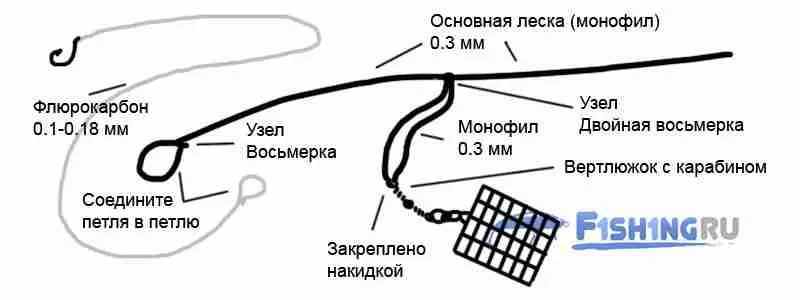
Paternoster Gardner is easy to knit on the main fishing line with your own hands right on the fishing trip:
1. Measure 50 cm from the tip of the fishing line and make a large loop 5-10 cm long. We knit 10 cm. Fix the loop with a figure-eight knot (it is easy to make and does not untie).
2. Inside the loop, put the swivel with a clasp using the cape method. For carp and other big fish use Owner swivels, they are very strong and reliable.
3. Fasten the feeder to the swivel with a clasp.
4. Pull the free end of the fishing line 0.3 mm towards the feeder and form another small loop at a point 3 cm below it. This is the attachment point for the future fluorocarbon leash. We measured a shoulder length of 15-18 cm (3 cm below the feeder) so that the thick line leading to the leash does not overlap with the feeder when casting or when taken out of the water.
5. Measure 1 m of fluorocarbon line and cut. On one side, form a loop with a figure-eight knot, and on the other, tie a hook.
6. The rig is ready. Do not attach the leash while feeding the fish. As soon as you make a starter feed, connect the loops using the “Loop to loop” method, put on the bait, and catch.
For Sport
This interesting variation of the paternoster is intended for sports feeder fishing, but it is no less popular among amateurs due to the speed of formation and catchability. The assembly of the “sport” modification is carried out according to the following principle:
1. A swivel with a clasp and a stopper is put on the main thread, stretching up the cord. A figure-eight knot is made at the tip of the warp, obtaining a loop for attaching the leash.
2. To the swivel we knit a piece of fishing line intended for attaching the feeder, arranging a fastener at the end, which is most easily done using the surgical loop technique.
3. In conclusion, we equip the knitting with a leash and a feeder.
4. The stopper regulates the course of the withdrawal with the feeder along the main thread.
Solid branch
The one-piece branch remotely resembles the previous one, it also uses feeder rubber, but not in the form of an insert, but in the form of a solid branch to the leash. But this is done not to strengthen the fishing line, but to get rid of the joints on the leash, that is, multiple loops and individual inserts.
This technique allows you to use the maximum length of the elastic, but you should carefully calculate the length of the leash and the shoulder with the feeder - the latter should be longer to avoid frequent overlaps.
In the process of knitting a paternoster, there are no particular difficulties, you just need to attach the feeder to the main line, and tie the elastic to it with a simple double knot, and make an additional knot at the attachment point.
Two Hooks
Anglers have increased the likelihood of bites by modifying the paternoster with the option of installing two hooks in the rig. The technique for forming the rig itself is completely identical to the classic or another version.
The only feature is the setting of additional leashes or hooks. In the loop connected to the feeder with a surgical knot at the end of the base, two leashes of different lengths can be mounted, or two hooks can be installed on one leash, maintaining a certain distance between them. A mounting option is practiced, where an additional leash should be on the basis in front of the feeder.
With feeder insert
A paternoster with a Feeder insert is relevant only under certain conditions, in particular, if the reservoir is not replete with large representatives of the ichthyofauna, and a thin line is used to catch them. In this case, an insert made of a feeder is used - a type of feeder rubber that makes the leash more durable.
By the way, it also has its advantages, with an insert, catches are lost much less often if fishing is carried out due to a rather steep edge, which is important in the process.
Such a paternoster for the feeder is knitted in the usual way, with the only difference being that the feeder is first inserted into the branch loop, and then the leash itself, according to the loop-in-loop principle. It is extremely simple and reliable.
With full loop
The difference in this modification lies in the formation of a large outlet loop, to which the feeder clings. Assembly instructions are performed in the following order:
1. On the main segment of the fishing line half a meter long, a large loop is knitted from the end.
2. The loop is folded in half and a knot is made with a figure eight so that the side outlet, and it will turn out in the form of a loop, is no longer than 10–12 cm, and the main cord is 25 cm.
3. At the end of the main thread, we tie a loop for attaching a leash.
4. We attach the feeder to the side continuous loop using a carabiner, and also connect the leash to the main fishing line and complete the installation.
Anti-tangle paternoster
Tie a twist if using Gardner’s loop or a classic Paternoster the leader is twisted and tangled with the main line and feeder. The diagram shows that the twist is longer than the outlet for the feeder, this is very important for creating an anti-tangle effect.
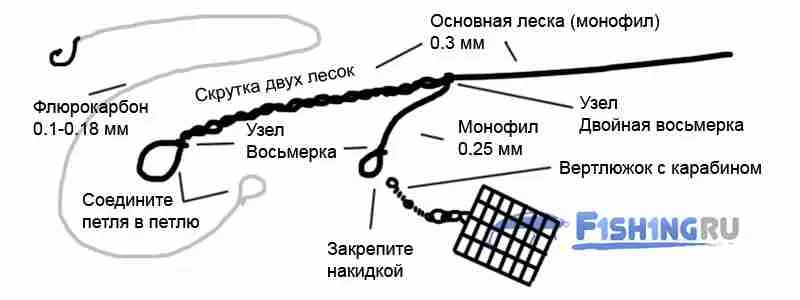
To form a twist on the Paternoster:
1. Fold the line in half.
2. Make the loop in a double-figure eight knot.
3. Then twist both ends of the fishing line between each other clockwise or counterclockwise so that a twist is formed - a tight segment twisted by two fishing lines.
4. Fix the end of the twist with another Double Eight knot so that it does not unwind.
A twist longer than the length of the outlet for the feeder will allow the leash not to twist around the equipment, and therefore, there will be much less entanglement when casting the tackle.
Competition Sliding Paternoster
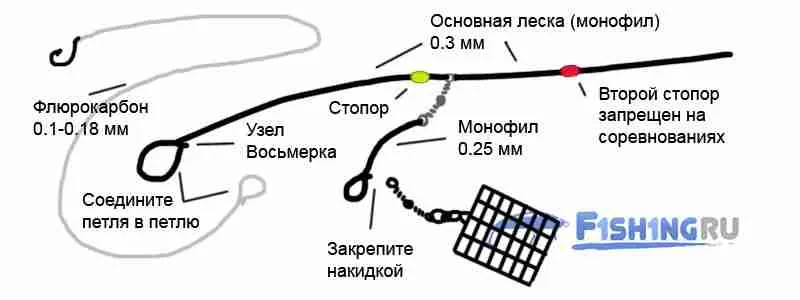
Competitive sliding Paternoster with the use of a bead stopper excludes the possibility of self-hooking of the fish, and therefore it is allowed at competitions where it is important to show skill and hook the fish after biting on the quiver-type of rod on your own.
Manufacturing instructions:
1. Thread the main line into the swivel (attach the lead for the feeder from a thin line to it later). Insert stopper.
2. We recommend a rubber fishing stopper, a plastic bead, or even a large knot, such as a double eight or a carrot, but then the eye of the swivel will have to be narrowed with pliers.
3. At the end of the fishing line, form a loop with a figure-eight knot.
4. Tie a 15 cm branch for the feeder to the swivel with a double clinch knot. At the end of the branch, form a loop for the load-feeder.
5. Fasten the feeder on the outlet using the cape method, and connect the loop under the fluorocarbon leash using the loop-to-loop method. The rig is ready.
The second stopper is prohibited in competition. If you place it at a distance of 15-20 cm from the first stopper, then the equipment will cease to be competitive, due to the self-locking effect. The fish, when pulling on the hook, will definitely bring the swivel to the stopper and will catch on the weight of the feeder.
The still-sliding Paternoster is ideal for carp fishing. In carp fishing, they do not use the tip of the rod (quiver tip) as a bite signal, but when fishing with this rig, you will have to look at the tip, otherwise, there is no point in building tackle with a feeder outlet. When using signaling devices, use other equipment, for example, Inline.
Cons of sliding equipment:
- There is no effect of self-hooking fish. It is more difficult for a beginner to catch, but for a professional this item will be a virtue.
Pros:
- Can be used in competition.
- Increased interest in fishing due to the sensitivity of the equipment, you will see the slightest touch of a large carp or bream. Safe for fish.
- When the tackle breaks, the prey will swim away only with a hook in its mouth, which is very likely to be easily disposed of. The feeder will remain at the bottom.
Loop on a leash
We make the loop for the leash small and neat - just to be able to attach.
The loop knot, as always in feeder installations, is a figure eight or a simple double (triple). The tail after the tie must be cut off almost under the knot itself. It shouldn’t stick out to the side. When casting, he can cling to the leash, as well as any debris on the bottom, which can interfere with the bite.
The same loop is made on the leash. In feeder fishing, it is customary to prepare leashes with eyelets of various lengths and diameters in advance so that you can quickly rearrange them during the fishing process. Experimenting with the selection of a working leash is part of the feeder technique, especially when working with a paternoster.

Feeder attachment
In the case of a Gardner rig, the feeder can simply be attached to the loop. It’s not worth tightening the loop too much, you need to throw it on the body of the swivel or the attachment of the feeder - suddenly you need to change it. We equip single-tap paternosters with a swivel with a carabiner.
Feeder fishing involves constant experimentation with rigs, including weights and feeder configurations. The clasp carabiner is convenient because you can quickly rearrange the feeder without bandaging the installation.
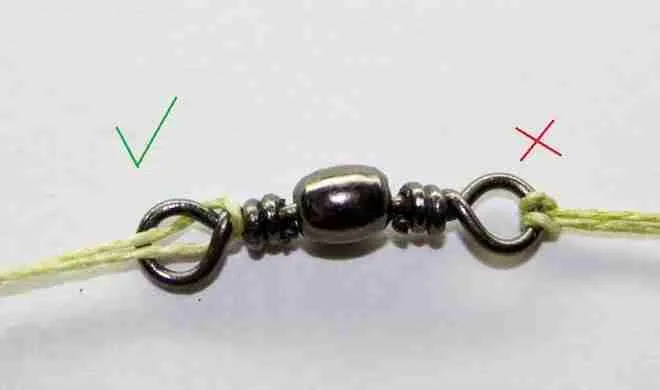
Where to use
Now let’s talk a little about where to use such tackle and under what conditions you will be able to notice its advantages over other types of mounting for fishing on the feeder.
- When fishing in stagnant water or in a weak current;
- On a rocky, peaty and muddy bottom (the leash always remains above the ground, and only the feeder sinks);
- On a flat and firm bottom.
The Gardner loop is accessible to any beginner due to its ease of manufacture. Due to its medium sensitivity, it has gained unprecedented popularity among sports fishermen. But no one imposes on you the use of such gear, everything is purely individual. Choose what is convenient for you, not for others.
Paternoster fishing
Fishing on a feeder means at first frequent, fast point casts in the same place in order to lure the fish. After 15-25 minutes of bait, expectant casts can be made. Cast from behind the back, actually from the horizontal position of the rod. After casting, do a little reeling immediately to make sure you don’t get caught on something.
When fishing in a strong current, it is important to consider the direction of the current.
Tips
1. If you find the corner of the edge (trough), do a little winding, or do a recast. With a bite and a sharp winding, you risk breaking the line.
2. Mix the bait with a small amount of clay from the reservoir you are going to fish on. So the bait will become more natural for the fish.
3. Feel free to experiment with attachments. Canned corn kernels are good for bream and carp, however, both maggots and corn can be mixed and placed on the hook.
4. When fishing in the current, and especially in a strong current, use only closed feeder feeders. The food from them is washed out pointwise and does not diverge over long distances, away from the leash.
5. The larger the fish, the larger the elements of the bait should be. Small baits are suitable for crucian carp, but massive baits are needed for bream, carp, carp and catfish (a bunch of maggots, worms, and beetles.)
6. To prevent rigging from becoming tangled, use knots, not carabiners, in the connections.
7. In order not to miss a bite, use bite alarms (bells, bells, electronic alarms).
8. When playing with a fish (especially large ones), make it tired, after which it is much easier to drag it to the shore.
Fishing for feeder fish can be a great way to attract larger fish to your area. There are a variety of different methods and options available for fishing for feeder fish, so be sure to do some research and find the best method and bait for your needs. With a little patience and effort, you can be sure to have a successful fishing trip.
